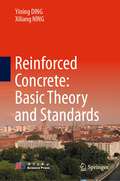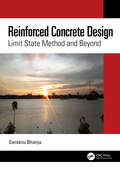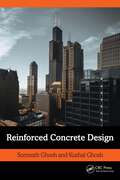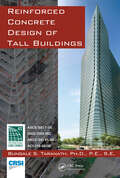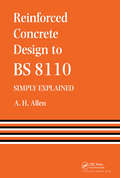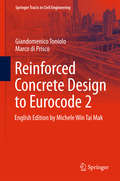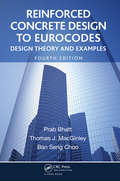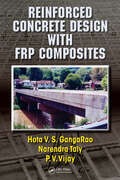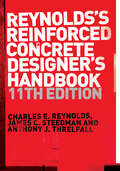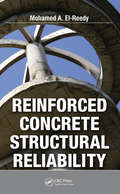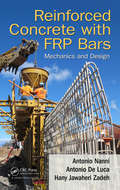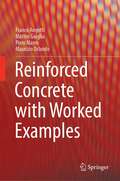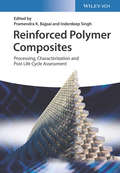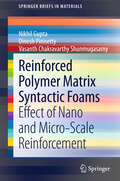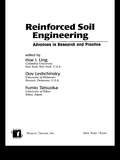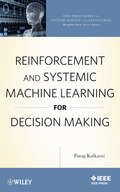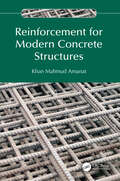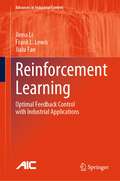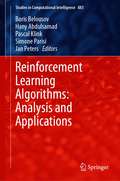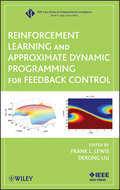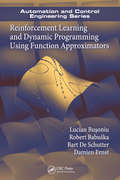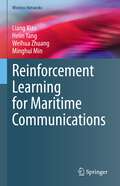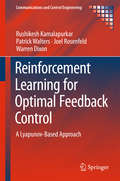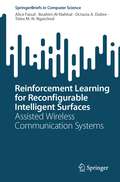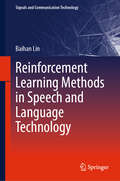- Table View
- List View
Reinforced Concrete: Basic Theory and Standards
by Yining DING Xiliang NINGThis book is intended to establish a bridge between the GB 50010, Fib MC2010, BS 8110 and ACI 318 or EC2. The respective pros and cons of different theories and methods according to various standards are compared or analyzed. Undergraduate and graduate students, foreign exchange students of international classes at Chinese universities who desire to work in China, or who are willing to work abroad in the field of civil engineering can benefit from the book. As such, this book provides valuable knowledge and useful design methods based on the different theories or guidelines.
Reinforced Concrete Design: Limit State Method and Beyond
by Santanu BhanjaReinforced Concrete Design (RC) is performed mostly by the limit state method throughout the world. This book covers the fundamental concepts and principles of RC design developing the topics from the basic theories and assumptions. Building upon the possible revisions to the mother code of concrete in India, IS:456-2000, it explains the RC design provisions of IRC:112-2020, which are in line with international standards. In addition to strength design, serviceability and ductility design are also covered.Features: Highlights the basic philosophy of RC design and behaviour of the sections up to and beyond limit state. Clarifies limit state theory from the basic assumptions provided in relevant Indian and international standards, IS:456, IRC:112 and Eurocode:2. Includes design aids or tools for standard and high strength concrete up to M90 grade as per different codes of practice. Explains the concept of ductility of reinforced concrete sections subjected to flexure with or without axial loads from fundamental principles. Covers fundamentals on serviceability requirements in reinforced concrete structures. Illustrates the design methodology of shear walls and includes design aids developed using basic principles as per relevant codes of practice. Explains reinforced concrete design provisions as per latest national and international standards and these are expected to be in line with those to be included in the forthcoming revision of IS:456. This book is aimed at graduate students, researchers and professionals in civil engineering, construction engineering and concrete.
Reinforced Concrete Design
by Somnath Ghosh Kushal GhoshThis book explains behavioral aspects of Reinforced Concrete (RCC) structures along with brief research to understand the codal recommendations in different countries. Related issues of RCC design are also discussed and these are supplemented by numerical/design examples and fundamental review questions in each chapter. The subject matter in this book also critically discusses the considerations for non-elastic behavior in design procedures to accommodate design objectives. A comparison of design methodology and output as per IS, BS, EURO and ACI Codes is also included.Features: Covers the basic behavioral aspects of reinforced concrete structures Includes design examples to understand the theoretical concepts of different modules Discusses considerations for non-elastic behavior for making simple design procedures to accommodate design objectives within codal provisions Provides the basic insights necessary for effective development of a design Includes a number of design examples along with working drawings This book is aimed at researchers; professionals; graduate students in RCC structures, civil and infrastructure engineering; and those involved in project execution and consultancy firms.
Reinforced Concrete Design of Tall Buildings
by Bungale S. TaranathAn exploration of the world of concrete as it applies to the construction of buildings, Reinforced Concrete Design of Tall Buildings provides a practical perspective on all aspects of reinforced concrete used in the design of structures, with particular focus on tall and ultra-tall buildings. Written by Dr. Bungale S. Taranath, this work explains t
Reinforced Concrete Design to BS 8110 Simply Explained
by A. AllenThis highly successful book describes the background to the design principles, methods and procedures required in the design process for reinforced concrete structures. The easy to follow style makes it an ideal reference for students and professionals alike.
Reinforced Concrete Design to Eurocode 2
by Marco Di Prisco Giandomenico TonioloThis textbook describes the basic mechanical features of concrete and explains the main resistant mechanisms activated in the reinforced concrete structures and foundations when subjected to centred and eccentric axial force, bending moment, shear, torsion and prestressing,. It presents a complete set of limit-state design criteria of the modern theory of RC incorporating principles and rules of the final version of the official Eurocode 2. This textbook examines methodological more than notional aspects of the presented topics, focusing on the verifications of assumptions, the rigorousness of the analysis and the consequent degree of reliability of results. Each chapter develops an organic topic, which is eventually illustrated by examples in each final paragraph containing the relative numerical applications. These practical end-of-chapter appendices and intuitive flow-charts ensure a smooth learning experience. The book stands as an ideal learning resource for students of structural design and analysis courses in civil engineering, building construction and architecture, as well as a valuable reference for concrete structural design professionals in practice.
Reinforced Concrete Design to Eurocodes: Design Theory and Examples, Fourth Edition
by Prab Bhatt Ban Seng Choo T.J. MacGinleyThis fourth edition of a bestselling textbook has been extensively rewritten and expanded in line with the current Eurocodes. It presents the principles of the design of concrete elements and of complete structures, with practical illustrations of the theory. It explains the background to the Eurocode rules and goes beyond the core topics to cover the design of foundations, retaining walls, and water retaining structures. The text includes more than sixty worked out design examples and more than six hundred diagrams, plans, and charts. It suitable for civil engineering courses and is a useful reference for practicing engineers.
Reinforced Concrete Design with FRP Composites
by Hota V.S. GangaRao Narendra Taly P. V. VijayAlthough the use of composites has increased in many industrial, commercial, medical, and defense applications, there is a lack of technical literature that examines composites in conjunction with concrete construction. Fulfilling the need for a comprehensive, explicit guide, Reinforced Concrete Design with FRP Composites presents specific informat
Reinforced Concrete Designer's Handbook
by Charles E. Reynolds James C. Steedman Anthony J. ThrelfallThis classic and essential work has been thoroughly revised and updated in line with the requirements of new codes and standards which have been introduced in recent years, including the new Eurocode as well as up-to-date British Standards. <P><P> It provides a general introduction along with details of analysis and design of a wide range of structures and examination of design according to British and then European Codes. <P><P> Highly illustrated with numerous line diagrams, tables and worked examples, Reynolds's Reinforced Concrete Designer's Handbook is a unique resource providing comprehensive guidance that enables the engineer to analyze and design reinforced concrete buildings, bridges, retaining walls, and containment structures. <P><P> Written for structural engineers, contractors, consulting engineers, local and health authorities, and utilities, this is also excellent for civil and architecture departments in universities and FE colleges.
Reinforced Concrete Structural Reliability
by Ph.D, Mohamed El-ReedyStructural engineers must focus on a structure's continued safety throughout its service life. Reinforced Concrete Structural Reliability covers the methods that enable engineers to keep structures reliable during all project phases, and presents a practical exploration of up-to-date techniques for predicting the lifetime of a structure. The book a
Reinforced Concrete with FRP Bars: Mechanics and Design
by Antonio Nanni Antonio De Luca Hany Jawaheri ZadehCorrosion-resistant, electromagnetic transparent and lightweight fiber-reinforced polymers (FRPs) are accepted as valid alternatives to steel in concrete reinforcement. Reinforced Concrete with FRP Bars: Mechanics and Design, a technical guide based on the authors more than 30 years of collective experience, provides principles, algorithms, and pr
Reinforced Concrete with Worked Examples
by Franco Angotti Matteo Guiglia Piero Marro Maurizio OrlandoThis textbook describes the design of reinforced and prestressed concrete structures according to the latest advances both in the field of materials, concrete and steel, and in the field of structural analysis. These advances have been included in current version of Eurocode 2, which is taken as reference. All subjects are presented starting from their theoretical bases and passing to corresponding EC2 formulations. A large part of the book is concerned with the most innovative EC2 parts, like nonlinear structural analyses, second-order effects, punching and strut-and-tie models. The textbook is equipped with numerous worked examples, useful for the reader who is not familiar with the design of reinforced and prestressed concrete structures by the Limit State Method. Examples have been chosen among the most frequent cases of the professional practice. Thanks to this structure, it can be of interest both to structural designers for their professional training and to students of engineering and architecture schools for their studies. The volume contains twelve chapters, which follow the same structure of EC2, except for chapter 6 (dealing with prestressed concrete structures), which does not match any chapter of EC2, as prestressed concrete is considered in EC2 as a particular case of reinforced concrete, and corresponding formulations are shed over different chapters.
Reinforced Polymer Composites: Processing, Characterization and Post Life Cycle Assessment
by Pramendra K. Bajpai Inderdeep SinghPresents state-of-the-art processing techniques and readily applicable knowledge on processing of polymer composites The book presents the advancement in the field of reinforced polymer composites with emphasis on manufacturing techniques, including processing of different reinforced polymer composites, secondary processing of green composites, and post life cycle processing. It discusses the advantages and limitations of each processing method and the effect of processing parameters on the overall performance of the composites. Characterization and applications of reinforced polymer composites are also introduced. Reinforced Polymer Composites: Processing, Characterization and Post Life Cycle Assessment starts off by providing readers with a comprehensive overview of the field. It then introduces them to the fabrication of both short fiber/filler reinforced polymer composites and laminated reinforced polymer composites. Next, it takes them through the processing of polymer-based nanocomposites; the many advances in curing methods of reinforced polymer composites; and post life cycle processing, re-processing, and disposal mechanisms of reinforced polymer composites. Numerous other chapters cover: synthetic versus natural fiber reinforced plastics; characterization techniques of reinforced plastics; friction and wear analysis of reinforced plastics; secondary processing of reinforced plastics; and applications of reinforced plastics. -Presents the latest development in materials, processing, and characterization techniques, as well as applications of reinforced polymer composites -Guides users in choosing the best processing methods to produce polymer composites and successfully manufacture high quality products -Assists academics in sorting out basic research questions and helps those in industry manufacture products, such as marine, automotive, aerospace, and sport goods Reinforced Polymer Composites: Processing, Characterization and Post Life Cycle Assessment is an important book for materials scientists, polymer chemists, chemical engineers, process engineers, and anyone involved in the chemical or plastics technology industry.
Reinforced Polymer Matrix Syntactic Foams
by Nikhil Gupta Dinesh Pinisetty Vasanth Chakravarthy ShunmugasamyReinforced Syntactic Foams: Effect of Nano and Micro-Scale Reinforcement examines the fabrication processes, mechanism of reinforcement, and structure-property correlations of reinforced syntactic foams. The authors present the state of the art in this field, compare the properties of various types of syntactic foam systems comprising different matrix, hollow particle, and reinforcement materials. The book further identifies theories useful in predicting the properties of reinforced syntactic foams and conducting parametric studies to understand the possibility for tailoring their properties.
Reinforced Soil Engineering: Advances in Research and Practice (Civil And Environmental Engineering Ser. #Vol. 14)
by Hoe I. Ling Dov Leshchinsky Fumio TatsuokaThis one-of-a-kind reference evaluates the efficacy, stability, and strength of various soil walls, slopes, and structures enhanced by geosynthetic materials. Offering stimulating contributions from more than 50 leading specialists in the field, Reinforced Soil Engineering compiles recent innovations in design layout, controlled construction, and geosynthetic material implementation for improved cost-efficiency, maintenance, and functioning in civil engineering applications. The book focuses on geotechnical earthquake issues and case histories from countries including the United States, Canada, Japan, Taiwan, Turkey, and other European nations.
Reinforcement and Systemic Machine Learning for Decision Making
by Parag KulkarniReinforcement and Systemic Machine Learning for Decision Making There are always difficulties in making machines that learn from experience. <P><P>Complete information is not always available--or it becomes available in bits and pieces over a period of time. With respect to systemic learning, there is a need to understand the impact of decisions and actions on a system over that period of time. This book takes a holistic approach to addressing that need and presents a new paradigm--creating new learning applications and, ultimately, more intelligent machines. The first book of its kind in this new and growing field, Reinforcement and Systemic Machine Learning for Decision Making focuses on the specialized research area of machine learning and systemic machine learning. It addresses reinforcement learning and its applications, incremental machine learning, repetitive failure-correction mechanisms, and multiperspective decision making. Chapters include: Introduction to Reinforcement and Systemic Machine Learning Fundamentals of Whole-System, Systemic, and Multiperspective Machine Learning Systemic Machine Learning and Model Inference and Information Integration Adaptive Learning Incremental Learning and Knowledge Representation Knowledge Augmentation: A Machine Learning Perspective Building a Learning System With the potential of this paradigm to become one of the more utilized in its field, professionals in the area of machine and systemic learning will find this book to be a valuable resource.
Reinforcement for Modern Concrete Structures
by Khan Mahmud AmanatThere are a lot of excellent textbooks on the design of reinforced concrete structures. However, based on professional experience of more than thirty years, the author feels that a separate book dedicated only to discuss the properties, behavior and use of reinforcement in concrete construction is highly justified. Conventional textbooks on concrete structures focus primarily on the mechanics of reinforced concrete design. Properties of reinforcement are discussed in a limited manner – only those which are deemed just adequate for discussing the theory of concrete mechanics. Typically, such books contain little or no background information or explanation as to why the various code provisions or rules regarding the reinforcement are imposed or formulated. It is observed that the application of modern materials and technologies in reinforcement manufacturing does not get proper attention or consideration in the engineering practices of many professionals. Based on the interaction with many engineers engaged in the design and construction of concrete structures, the author feels that there is a lack of the essential background knowledge of the engineering properties and behavior of concrete reinforcement among many of them. And such a lack of knowledge often leads to improper implementation of the code design provisions. Limited scope of our existing engineering curricula is primarily responsible for this. This book has been written with an aim to fill this gap and to make engineering students and practicing engineers more up-to-date.
Reinforcement Learning: Optimal Feedback Control with Industrial Applications (Advances in Industrial Control)
by Jinna Li Frank L. Lewis Jialu FanThis book offers a thorough introduction to the basics and scientific and technological innovations involved in the modern study of reinforcement-learning-based feedback control. The authors address a wide variety of systems including work on nonlinear, networked, multi-agent and multi-player systems. A concise description of classical reinforcement learning (RL), the basics of optimal control with dynamic programming and network control architectures, and a brief introduction to typical algorithms build the foundation for the remainder of the book. Extensive research on data-driven robust control for nonlinear systems with unknown dynamics and multi-player systems follows. Data-driven optimal control of networked single- and multi-player systems leads readers into the development of novel RL algorithms with increased learning efficiency. The book concludes with a treatment of how these RL algorithms can achieve optimal synchronization policies for multi-agent systems with unknown model parameters and how game RL can solve problems of optimal operation in various process industries. Illustrative numerical examples and complex process control applications emphasize the realistic usefulness of the algorithms discussed. The combination of practical algorithms, theoretical analysis and comprehensive examples presented in Reinforcement Learning will interest researchers and practitioners studying or using optimal and adaptive control, machine learning, artificial intelligence, and operations research, whether advancing the theory or applying it in mineral-process, chemical-process, power-supply or other industries.
Reinforcement Learning Algorithms: Analysis and Applications (Studies in Computational Intelligence #883)
by Boris Belousov Hany Abdulsamad Pascal Klink Simone Parisi Jan PetersThis book reviews research developments in diverse areas of reinforcement learning such as model-free actor-critic methods, model-based learning and control, information geometry of policy searches, reward design, and exploration in biology and the behavioral sciences. Special emphasis is placed on advanced ideas, algorithms, methods, and applications. The contributed papers gathered here grew out of a lecture course on reinforcement learning held by Prof. Jan Peters in the winter semester 2018/2019 at Technische Universität Darmstadt. The book is intended for reinforcement learning students and researchers with a firm grasp of linear algebra, statistics, and optimization. Nevertheless, all key concepts are introduced in each chapter, making the content self-contained and accessible to a broader audience.
Reinforcement Learning and Approximate Dynamic Programming for Feedback Control (IEEE Press Series on Computational Intelligence #17)
by Frank L. Lewis Derong LiuReinforcement learning (RL) and adaptive dynamic programming (ADP) has been one of the most critical research fields in science and engineering for modern complex systems. This book describes the latest RL and ADP techniques for decision and control in human engineered systems, covering both single player decision and control and multi-player games. Edited by the pioneers of RL and ADP research, the book brings together ideas and methods from many fields and provides an important and timely guidance on controlling a wide variety of systems, such as robots, industrial processes, and economic decision-making.
Reinforcement Learning and Dynamic Programming Using Function Approximators (Automation and Control Engineering)
by Lucian Busoniu Robert Babuska Damien Ernst Bart De SchutterFrom household appliances to applications in robotics, engineered systems involving complex dynamics can only be as effective as the algorithms that control them. While Dynamic Programming (DP) has provided researchers with a way to optimally solve decision and control problems involving complex dynamic systems, its practical value was limited by algorithms that lacked the capacity to scale up to realistic problems. However, in recent years, dramatic developments in Reinforcement Learning (RL), the model-free counterpart of DP, changed our understanding of what is possible. Those developments led to the creation of reliable methods that can be applied even when a mathematical model of the system is unavailable, allowing researchers to solve challenging control problems in engineering, as well as in a variety of other disciplines, including economics, medicine, and artificial intelligence. Reinforcement Learning and Dynamic Programming Using Function Approximators provides a comprehensive and unparalleled exploration of the field of RL and DP. With a focus on continuous-variable problems, this seminal text details essential developments that have substantially altered the field over the past decade. In its pages, pioneering experts provide a concise introduction to classical RL and DP, followed by an extensive presentation of the state-of-the-art and novel methods in RL and DP with approximation. Combining algorithm development with theoretical guarantees, they elaborate on their work with illustrative examples and insightful comparisons. Three individual chapters are dedicated to representative algorithms from each of the major classes of techniques: value iteration, policy iteration, and policy search. The features and performance of these algorithms are highlighted in extensive experimental studies on a range of control applications. The recent development of applications involving complex systems has led to a surge of interest in RL and DP methods and the subsequent need for a quality resource on the subject. For graduate students and others new to the field, this book offers a thorough introduction to both the basics and emerging methods. And for those researchers and practitioners working in the fields of optimal and adaptive control, machine learning, artificial intelligence, and operations research, this resource offers a combination of practical algorithms, theoretical analysis, and comprehensive examples that they will be able to adapt and apply to their own work. Access the authors' website at www.dcsc.tudelft.nl/rlbook/ for additional material, including computer code used in the studies and information concerning new developments.
Reinforcement Learning for Maritime Communications (Wireless Networks)
by Liang Xiao Helin Yang Weihua Zhuang Minghui MinThis book demonstrates that the reliable and secure communication performance of maritime communications can be significantly improved by using intelligent reflecting surface (IRS) aided communication, privacy-aware Internet of Things (IoT) communications, intelligent resource management and location privacy protection. In the IRS aided maritime communication system, the reflecting elements of IRS can be intelligently controlled to change the phase of signal, and finally enhance the received signal strength of maritime ships (or sensors) or jam maritime eavesdroppers illustrated in this book.The power and spectrum resource in maritime communications can be jointly optimized to guarantee the quality of service (i.e., security and reliability requirements), and reinforcement leaning is adopted to smartly choose the resource allocation strategy. Moreover, learning based privacy-aware offloading and location privacy protection are proposed to intelligently guarantee the privacy-preserving requirements of maritime ships or (sensors). Therefore, these communication schemes based on reinforcement learning algorithms can help maritime communication systems to improve the information security, especially in dynamic and complex maritime environments.This timely book also provides broad coverage of the maritime wireless communication issues, such as reliability, security, resource management, and privacy protection. Reinforcement learning based methods are applied to solve these issues. This book includes four rigorously refereed chapters from prominent international researchers working in this subject area. The material serves as a useful reference for researchers, graduate students. Practitioners seeking solutions to maritime wireless communication and security related issues will benefit from this book as well.
Reinforcement Learning for Optimal Feedback Control: A Lyapunov-based Approach (Communications and Control Engineering)
by Warren Dixon Joel Rosenfeld Patrick Walters Rushikesh KamalapurkarReinforcement Learning for Optimal Feedback Control develops model-based and data-driven reinforcement learning methods for solving optimal control problems in nonlinear deterministic dynamical systems. In order to achieve learning under uncertainty, data-driven methods for identifying system models in real-time are also developed. The book illustrates the advantages gained from the use of a model and the use of previous experience in the form of recorded data through simulations and experiments. The book’s focus on deterministic systems allows for an in-depth Lyapunov-based analysis of the performance of the methods described during the learning phase and during execution. To yield an approximate optimal controller, the authors focus on theories and methods that fall under the umbrella of actor–critic methods for machine learning. They concentrate on establishing stability during the learning phase and the execution phase, and adaptive model-based and data-driven reinforcement learning, to assist readers in the learning process, which typically relies on instantaneous input-output measurements. This monograph provides academic researchers with backgrounds in diverse disciplines from aerospace engineering to computer science, who are interested in optimal reinforcement learning functional analysis and functional approximation theory, with a good introduction to the use of model-based methods. The thorough treatment of an advanced treatment to control will also interest practitioners working in the chemical-process and power-supply industry.
Reinforcement Learning for Reconfigurable Intelligent Surfaces: Assisted Wireless Communication Systems (SpringerBriefs in Computer Science)
by Alice Faisal Ibrahim Al-Nahhal Octavia A. Dobre Telex M. NgatchedThis book presents the intersection of two dynamic fields: Reinforcement Learning (RL) and RIS- Assisted Wireless Communications. With an emphasis on both discrete and continuous problems, it introduces a comprehensive overview of RL techniques and their applications in the evolving world of RIS-assisted wireless communications. Chapter 1 introduces the fundamentals of RL and deep RL (DRL), providing a solid foundation for understanding subsequent chapters. It also presents the Q-learning, deep Q-learning, and deep deterministic policy gradient algorithms. Chapter 2 provides a holistic overview of RIS-assisted systems and details several use cases in wireless communications. Then, Chapters 3 and 4 present various applications of the discrete and continuous DRL to RIS-assisted wireless communications. From maximizing the sum-rate to minimizing, the system resources and maximizing the energy efficiency. These chapters showcase the versatility of the DRL algorithms in tackling arange of challenges. This book concludes with Chapter 5, which introduces the challenges and future directions in this field. It explores the particulars of hyperparameter tuning, problem design, and complexity analysis, while also highlighting the potential of hybrid DRL, multi-agent DRL, and transfer learning techniques for advancing wireless communication systems. Optimizing RIS-Assisted Wireless Systems requires powerful algorithms to cope with the dynamic propagation environment. DRL is envisioned as one of the key enabling techniques to exploit the full potential of RIS-Assisted Wireless Communication Systems. It empowers these systems to intelligently adapt to dynamic wireless environments, maximize performance metrics, and adjusts their configurations to accommodate diverse use cases efficiently. This book serves as a valuable resource, shedding light on the potential of DRL to optimize RIS-Assisted Wireless Communication, enabling researchers, engineers, advanced level students in computer science and electrical engineering and enthusiasts to grasp the intricacies of this topic. It offers a comprehensive understanding of the principles, applications, and challenges, making it a reference to recognize the full potential of the RIS technology in modern wireless communication systems.
Reinforcement Learning Methods in Speech and Language Technology (Signals and Communication Technology)
by Baihan LinThis book offers a comprehensive guide to reinforcement learning (RL) and bandits methods, specifically tailored for advancements in speech and language technology. Starting with a foundational overview of RL and bandit methods, the book dives into their practical applications across a wide array of speech and language tasks. Readers will gain insights into how these methods shape solutions in automatic speech recognition (ASR), speaker recognition, diarization, spoken and natural language understanding (SLU/NLU), text-to-speech (TTS) synthesis, natural language generation (NLG), and conversational recommendation systems (CRS). Further, the book delves into cutting-edge developments in large language models (LLMs) and discusses the latest strategies in RL, highlighting the emerging fields of multi-agent systems and transfer learning. Emphasizing real-world applications, the book provides clear, step-by-step guidance on employing RL and bandit methods to address challenges in speech and language technology. It includes case studies and practical tips that equip readers to apply these methods to their own projects. As a timely and crucial resource, this book is ideal for speech and language researchers, engineers, students, and practitioners eager to enhance the performance of speech and language systems and to innovate with new interactive learning paradigms from an interface design perspective.
